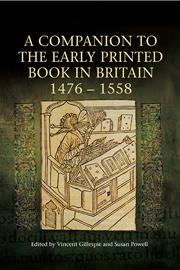Book contents
- Frontmatter
- Contents
- List of Illustrations
- List of Contributors
- Preface
- Acknowledgements
- Abbreviations
- Chronology of the Period
- Introduction
- I THE PRINTED BOOK TRADE
- II THE PRINTED BOOK AS ARTEFACT
- III PATRONS, PURCHASERS AND PRODUCTS
- IV THE CULTURAL CAPITAL OF PRINT
- 12 Humanism and Printing
- 13 Women Translators and the Early Printed Book
- 14 The Printed Book Trade in Response to Luther: English Books Printed Abroad
- 15 Thomas More, Print and the Idea of Censorship
- 16 Catholicism, the Printed Book and the Marian Restoration
- Index of Manuscripts
- Index of Printed Books
- General Index
14 - The Printed Book Trade in Response to Luther: English Books Printed Abroad
from IV - THE CULTURAL CAPITAL OF PRINT
Published online by Cambridge University Press: 05 April 2014
- Frontmatter
- Contents
- List of Illustrations
- List of Contributors
- Preface
- Acknowledgements
- Abbreviations
- Chronology of the Period
- Introduction
- I THE PRINTED BOOK TRADE
- II THE PRINTED BOOK AS ARTEFACT
- III PATRONS, PURCHASERS AND PRODUCTS
- IV THE CULTURAL CAPITAL OF PRINT
- 12 Humanism and Printing
- 13 Women Translators and the Early Printed Book
- 14 The Printed Book Trade in Response to Luther: English Books Printed Abroad
- 15 Thomas More, Print and the Idea of Censorship
- 16 Catholicism, the Printed Book and the Marian Restoration
- Index of Manuscripts
- Index of Printed Books
- General Index
Summary
When the York publisher and bookseller Gerard Freez, who was probably of Dutch origin, died in 1510, his stock was found to include well over a thousand liturgical volumes purchased in France and brought to England. Of these titles fewer than three hundred still survive anywhere from this period. This massive loss of pre-Reformation liturgical material has obscured an important aspect of late medieval Catholicism: it was a religion of the book. Sacramental grace required the use of the correct liturgical words and the new technology of printing held out the hope of imposing verbal uniformity in ways that had not been possible before. Late medieval religion may have been a religion of performance, but it was words that were performative. A book trade rapidly developed to satisfy this liturgical need. Such books were often complex productions and demanded skills and experience that English printers often did not have. Liturgical texts of this type had a core of text which was common across Christendom, to which were added local variations, and it was thus possible from a single centre, say Venice or Paris, to produce books for a wide geographical market.
- Type
- Chapter
- Information
- A Companion to the Early Printed Book in Britain, 1476-1558 , pp. 272 - 289Publisher: Boydell & BrewerPrint publication year: 2014

